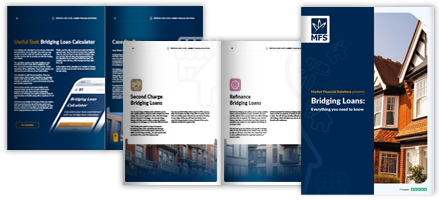
Written by Scott Lord
Deputy Chief Mortgage & Operations Officer – Front End
Market Financial Solutions are a bridging loan and buy-to-let mortgage provider and are not legal, financial, investment or tax advisers. This document is for informational purposes only and does not, and should not be considered, to constitute legal, financial, investment or tax advice or be relied upon by any person to make a legal, financial, investment or tax decision. Therefore, Investors are encouraged to seek appropriate professional advice. The information in this content is correct at time of writing.

There can be many bridging loan benefits, covering a broad range of situations. From keeping a chain from falling through to expanding a portfolio, specialist finance can help investors stuck in tricky circumstances. Despite this, buyers may ask themselves: Are bridging loans a good idea for my specific property plans?
To shed light on this question and elaborate on bridging loan benefits, let’s first look at what these loans are. Bridging loans are a form of short-term finance, available to both individuals and companies who need to ‘bridge’ payment gaps. For example, a buyer who is selling a property may wish to purchase a new asset before their sale completes.
Another example would be the need to purchase a property quickly due to it being a good offer that may not last long. Buyers may not have time to arrange traditional long-term finance, such as a mortgage. As such, a bridge loan can ‘bridge’ the gap between the initial purchase and long-term financial security.
There are many other reasons why people use bridging finance over traditional forms of finance and we’re here to discuss:
- How to recognise these bridging loan benefits
- Whether bridging loans are a good idea
- What to consider when looking to see if they right for you
4 Reasons why bridging loans are a good idea:
Reason 1: Flexibility
One of the key bridging loan benefits are the products’ flexibility. Unlike a traditional mortgage, unregulated bridging loans do not adhere to tick-box lending criteria. This means they can be shaped around an array of different property types. Bridging loans are often tailored to suit borrowers’ individual financial circumstances. For example, they could be used to:
- Help clear adverse credit
- Provide bespoke finance for complex company structures
- Aid offshore clients who may struggle to find traditional long-term finance without a UK credit footprint needed
Reason 2: Speed
Another reason why bridging loans are a good idea is their speed. Instead of taking months, a bridge loan could see funds in your account in as little as three days. This means you could complete a property purchase quickly, minimising the risk of being out-bid, gazumped or stuck in a long property chain.
This is particularly important as the longer a chain, the higher the risk of a deal collapsing. Bridging loans can help overcome this issue, you can read more on this here. If you’d like to find out more about tactics such as gazumping, then read our independent research in our latest report.
Whilst we provide short-term funding, you can organise traditional finance as a long-term solution without the worry of missing out on a great investment opportunity.
Reason 3: Reliability
When facing tight deadlines, reliability is key. This is where bridging lenders come in. Due to their speed, bridge loans can be used to secure property quickly in transactions where time is of the essence. For example, when buying a residential or commercial property via auction.
Often, auction houses have a tight deadline in which buyers need to complete the sale of their property; on average this is 28 days. Failure to meet this deadline can put borrowers at risk of their purchase falling through. This can be costly, as buyers would lose the deposit paid on the day (generally 10% of their winning bid) as well as the property they bid on. You can find out more about how auctions work and the why bridging loans are a good idea in an auction setting by downloading our free Guide to Property Auctions.
Reason 4: Increase property value
Neglected or damaged properties can hold great potential for increasing yield by unlocking ‘hidden’ equity. Damage can lead to undervalued properties, making them attractive renovation projects for investors. A bridging loan allows you to take advantage of these properties with no delays. Works can start imminently to increase a property’s value, with the hope to sell the asset on for a profit.
Are bridging loans a good idea for me?
When it comes to asking, ‘are bridging loans a good idea?’ there are many factors apart from the benefits you need to consider. Firstly, you need to ask whether it is the right choice for you. How do you decide this? Well, here are a few starting points:
Uses of bridging loans
A key way to recognise whether a bridging loan is a good idea for your circumstance is to consider what you need it for. Being a form of specialist finance, the list of lenders is sparse, particularly if you’re looking at bespoke bridging lenders like us.
Here are ten examples of common uses that you may wish to consider:
- Overcoming mortgage delays
- Capital raising
- Funding conversation or refurbishment projects
- Starting a new or expand a business venture
- Refinancing
- Expanding a portfolio
- Creating breathing space when building new properties
- Clearing adverse credit
- Minimising the risk of being gazumped
- Purchasing a property via auction
You can also read our Top 5 uses of commercial bridging loans for further examples.

The most beneficial bridging loan for you
The next step is to consider the type of property you’re looking at:
Residential and buy-to-let
This covers the purchase of property investments from:
- Standard buy-to-lets
- Houses in multiple occupation (HMOs)
- Student lets
It is important to note unregulated lenders are unable to provide finance to purchase a home you may be looking to reside in yourself. This will require regulated finance. If you’d like to find out more about the difference between regulated and unregulated finance and their benefits, then you can find out everything you need to know here.
Commercial and semi-commercial
A commercial bridge loan is available to help buyers purchase a property used to host a business, such as:
- Offices
- Warehouses
- Bed and breakfasts / hotels
- Shopping centres
A semi-commercial bridging loan is available for assets hosting both residential dwellings and space for a company which generates an income. For example:
- Takeaways with flats above them
- Shopping centres with one or more apartments attached
Permitted & light development
There are three key areas of property improvements that fall under permitted and light development loans and can benefit you:
- Refurbishing: When a buyer looks to improve the overall quality, and therefore value, of a property.
- Renovating: The act of modernising or improving a damaged/old property.
- Converting: A project that changes the use or function of a building or room, such as a loft conversion or converting a buy-to-let into an HMO.
To find out more about these three elements of property renovation, download our guide here.
Developer exit
When building new homes, developers often take out a development loan to start their ground-up works. However, schedules may not always go to plan. Supplies might be delayed; workers may fall ill or there could be onsite delays due to bad weather.
Through the benefits of a developer exit loan, developers can repay their development loan without facing expensive extension charges. These charges can be levied for things out of their control and to avoid this, the loans could help:
- Finish minor refurbishment works which have been delayed
- Find a buyer without having to decrease property value to meet development finance deadlines
Second charge
In some cases, lenders who already have finance secured against their property (such as a mortgage) may require additional finance. Securing another loan behind your initial loan is called a second charge. Second charge loans can be used to raise additional funds for:
- A deposit for another property
- Property renovation works
- Starting a new business venture
There is a lot to consider when looking at short-term and asking whether or not bridging loans are a good idea.
The Complete Guide to
Bridging Loans
Everything you need to know
- Different bridging types
- Useful tools
- Apply them in real life
- Market insights & more





